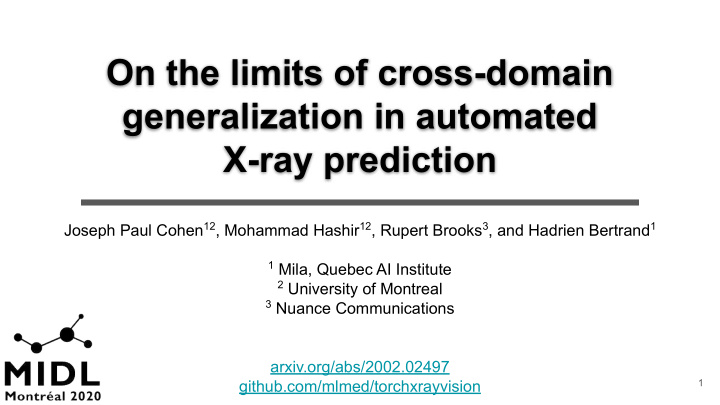



On the limits of cross-domain generalization in automated X-ray prediction Joseph Paul Cohen 12 , Mohammad Hashir 12 , Rupert Brooks 3 , and Hadrien Bertrand 1 1 Mila, Quebec AI Institute 2 University of Montreal 3 Nuance Communications arxiv.org/abs/2002.02497 github.com/mlmed/torchxrayvision 1
What would lead to such strange results? Initial results when evaluating a model trained on NIH data on an external dataset from Spain. An online post about the system indicated some contention about these labels. Test data (AUC) Bálint Botz - Evaluating chest x-rays using AI in your NIH PadChest browser? — testing Chester, April 2019. (Maryland, US) (Spain) Mass 0.88 0.89 Nodule 0.81 0.74 Pneumonia 0.73 0.83 Consolidation 0.82 0.91 Infiltration 0.73 0.60
Many datasets exist with different methods of obtaining labels. Automatic or hand labelled NIH chest X-ray14 PADCHEST, ~200 labels CheXpert, 13 labels MIMIC-CXR, 13 labels 14 labels 27% hand labelled, others Custom rule-based Automated rule-based Automated rule-based using an RNN. labeler. labeler. NIH (NegBio) and labeler (NegBio) CheX labelers used. RSNA Pneumonia Kaggle A group at Google MeSH automatic labeller Relabelled NIH data relabelled a subset of NIH 3/28 images
Label agreement between datasets which relabel NIH images Poor agreement! 4/28
Good Experiment: To investigate, a cross domain evaluation is performed. The 5 largest datasets are trained and evaluated on. Medium Note: MIMIC_NB and MIMIC_CH only vary based on the automatic labeller. Variable Task specific agreement! 5/28 https://arxiv.org/abs/2002.02497
We may blame poor generalization We model: performance on a shift in x ( covariate shift ) but this would not account why for some y (tasks) it works well. It seems more likely that there is some Possibly reality shift in y ( concept shift ) which would force us to condition the prediction. But we want objective predictions! 6/28
What is causing this shift? ● Errors in labelling as discussed by Oakden-Rayner (2019) and Majkowska et al. (2019), in part due to automatic labellers. ● Discrepancy between the radiologist’s vs clinician’s vs automatic labeller’s understanding of a radiology report (Brady et al., 2012). ● Bias in clinical practice between doctors and their clinics (Busby et al., 2018) or limitations in objectivity (Cockshott & Park, 1983; Garland, 1949). ● Interobserver variability (Moncada et al., 2011). It can be related to the medicalculture, language, textbooks, or politics. Possibly even conceptually (e.g. footballs between USA and the world). Are there limits to how well we can generalize for some tasks? 7/28
We may think that training on local data is addressing covariate shift Cross domain validation analysis. Average over 3 seeds for all labels. local domain external domains local+external domains However, training on local data provides better performance than using the larger external datasets. This may imply the model is only adapting to the local biases in the data which may not match the reality in the images. 8/28
How to study concept shift? We can use the weight vector at the classification layer for a specific task (just a logistic regression) a: feature vector length t: number of tasks d: number of domains Minimize pairwise distances ... between each weight vector of For the same task. each class If each weight vector doesn't merge together then some concept drift is only this matrix pulling them apart. is regularized 9/28 Network figure credit: Sara Sheehan
With regularization Without regularization 10/28
Do distances between weight vectors explain anything about generalization? Sorted based on average distance over 3 seeds some tasks are grouped together easier than others. 11/28
Conclusions ● The community may want to focus on concept shift over covariate shift in order to improve generalization. ● Better automatic labeling may not be the answer. ○ General disagreement between radiologists or subjectivity in what is clinically relevant to include in a report. ● We can consider each task prediction as defined by its training data such as "NIH Pneumonia'' or "CheXpert Edema" each possibly providing a unique biomarker. The output of multiple models can be presented to a user. ● It does not seem like a solution to train on a local data from a hospital. 12/28
Thanks! arxiv.org/abs/2002.02497 github.com/mlmed/torchxrayvision 13
Recommend
More recommend